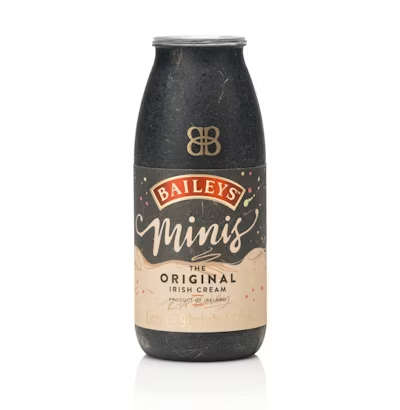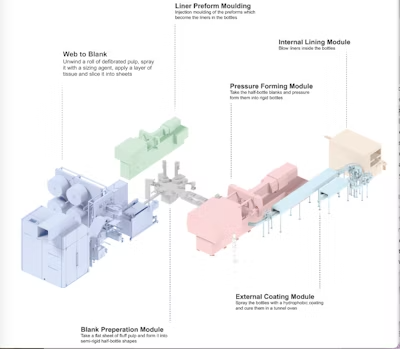How Baileys Paper-Based Bottle is Made
An extraordinary network of inventors, developers, OEMs, and stakeholders emphasize ‘progress over perfection’ as they commercialize a breakthrough bottle.
By - Pat Reynolds
London-based Diageo—the maker of Johnnie Walker Scotch Whisky, Don Julio Tequila, and Guinness—recently tested paper-based bottles for Baileys, the Original Irish Cream Liqueur. Made of 90% paper and including a thin PET liner, the bottles are designed for recycling in standard paper streams and do not require the consumer to separate the PET liner when disposing.
The packages were made by way of Dry Molded Fiber technology, invented by Sweden’s PulPac and covered by multiple patents. Completing the noteworthy package are an induction-sealed foil lid and a pressure-sensitive paper label with hot-stamped gold used for the gold double B symbol at the top of the bottle. The trial took place May 25- 26 at Time Out Fest in Barcelona, Spain, where 2,000 mini Baileys containers each holding 80 mL were made available to those who attended the food fest.
To understand why Dry Molded Fiber is potentially such a game changer it helps to point out that the tried and true method of forming fiber into packaging—think egg cartons, for example—involves considerable time, energy, and water. It begins with paper, typically recycled materials such as newspapers, paperboard, and other types of paper waste. These are pulped to break them down into individual fibers, and the pulp is then mixed with water to create a slurry. This slurry is poured into a mold designed to create a consistent shape and size for the egg cartons. Next is a press, which applies pressure to remove excess water from the pulp. Last comes drying to remove any remaining moisture.
This is a slow and resource-intensive process, one that Dry Molded Fiber technology is able to sidestep. PulPac claims that Dry Molded Fiber is 10 times faster than conventional wet molded fiber methods. Once it gets fully scaled up, say its backers, it will be a way of converting renewable plant fibers into fully recyclable packaging that can replace single-use plastic at a cost that is competitive. Other benefits include low energy use and almost no water demand in the molding process. This results in a package with strong sustainability credentials. Initial screening Life Cycle Assessment data for the Baileys bottle suggests it will have 25% lower CO2 emissions than the current rPET package.
It’s important to note that Dry Molded Fiber technology can be used to form almost any three-dimensional packaging product. (See sidebar below for a description of how the technology is used to make paper cutlery or cup lids used in the foodservice industry.) In this account we’ll focus on how the Baileys bottle was made. But before looking at the bottle-making technology itself, it’s essential to look at the PulPac business model and the network of partners and co-developers upon whose shoulders the Baileys bottle stands. 
As for the PulPac business model, they own the Intellectual Property behind Dry Molded Fiber but they are not builders of container-making machinery. They get a per part royalty fee from container-making converters who sign a licensing agreement with them. The converters buy container-making equipment built by OEMs that PulPac has identified as a turnkey provider. (Scroll down for a sidebar on one such turnkey provider, JOA.)
Getting back to the Baileys test, which at 2,000 bottles was small in scale to say the least, the bottles were made at PA Consulting’s Global Innovation and Technology Centre in Cambridge, U.K. They were then transported to Ireland to be filled and induction sealed by the Baileys’ team at the filling site prior to shipment to the Barcelona test site. This was Diageo’s first consumer facing trial with paper-based bottles. It tested not only how the bottles traveled from Ireland to Barcelona, but also how consumers interacted with the material and how they understood the sustainability credentials of a paper bottle.
The bottle-making line used at PA Consulting’s Cambridge facility, called the Demonstrator Line, represents Phase 2 in the Bottle Collective’s push toward full-scale commercial Dry Molded Fiber bottle production. In Phase 1, bottles were created using adapted machinery and manual transfer between process steps. With the Demonstrator Line comes more automation, as the process is divided into six integrated modules that work together with little human intervention. The Demonstrator Line not only increases efficiency and throughput for bottle production, it also provides a testing and learning environment to help the Bottle Collective prepare for production at true commercial scale. This schematic drawing illustrates the six main modules of the Demonstrator Line on which the Baileys bottles were produced.
This schematic drawing illustrates the six main modules of the Demonstrator Line on which the Baileys bottles were produced.
The six modules of the Demonstrator Line can be seen in the illustrated schematic above. Module 1 is called Web to Blank. The large blue box is a mill into which rolls of fluff pulp are fed. The mill grinds the fluff pulp to separate the fibers from each other, and these fluff pulp fibers are “air laid” onto a roll-fed tissue paper that rides on a conveyor belt running at an incline. Next is a series of rollers where a couple of things happen, including a spray application of AKD (alkyl ketene dimer), a sizing agent commonly used to bring hydrophobicity to paper substrates of all kinds. In other words, the sizing agent helps the paper resist absorption of moisture.
The last thing that happens in Module 1 is the continuous roll of material is cut into blanks. These blanks are fed into Module 2, the Blank Preparation Module. Here the flat blank that was created in Module 1 is folded and manipulated to form a semi-rigid half-bottle shape. Meanwhile, in Module 3 or Liner Preform Molding, a PET preform is injection molded. In Module 4, the pink one, the two bottle halves are enclosed in a mold so that heat and pressure can be used to join the two half bottles into one full bottle. A physical reaction called “hydrogen bonding” creates a firm bond where the two bottle halves meet at what would be called the “parting line” in extrusion blow molding of plastic bottles. In Module 5, bottle exteriors are sprayed with a hydrophobic coating followed by curing in a tunnel oven. Other coatings can also be sprayed on here depending on what kind of product is involved. Finally, in Module 6, the PET preform, now inside the bottle, is blown out to the interior sidewalls.
Worth noting is that MCC Labels is working closely with the Bottle Collective to make it possible to do in-mold paper labeling in the Blank Preparation Module. Another firm providing valuable input in the injection-molding part of the puzzle has been Arburg. In describing the Arburg contribution, PA Consulting’s Stone says this.
“Throughout the ongoing development process we keep buying Arburg equipment and immediately invalidating the warranty by taking it apart and putting it back together in a different order. But we make sure we show them what we did and precisely why. This way, ultimately, we will show what needs to happen so that the ecosystem of machinery builders will make true commercialization happen. That's how this technology will scale. It's not like we're not trying to hold the secrets. Instead, we're trying to invent it and build mass scale very quickly. Throughout that process, our relationship with PulPac doesn't change. And they still take a royalty per part on that business when it gets there.”
The Demonstrator Line is capable of something like 300 bottles/hr. The line PA Consulting would like to see running in the near future will produce more like 3,000 bottles per hour. Who will operate that line remains to be seen. Presumably it will be a converter funded by the Bottle Collective.
Words like “presumably” and “who will operate that line” permeate any current discussion of what PulPac, PA Consulting, and the Bottle Collective are trying to accomplish. All stakeholders involved readily acknowledge that there’s a ways to go. But the overriding attitude is perhaps best expressed by Diageo’s Ewan Andrew, president, global supply chain and procurement and chief sustainability officer. “When it comes to our packaging,” he says, “we’re taking an approach of progress over perfection, knowing our packaging will need to evolve along with consumer needs and technological advancements. The consumer is becoming more sustainability savvy and we believe we can meet that need using our design and innovation to bring premium products and more sustainable solutions together.”
Originally posted: https://www.packworld.com/rigid/containers-closures/article/22913992/how-baileys-paperbased-bottle-is-made
Additional Info
Related Links : https://www.packworld.com/rigid/containers-closures/article/22913992/how-baileys-paperbased-bottle-is-made
